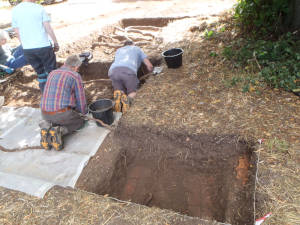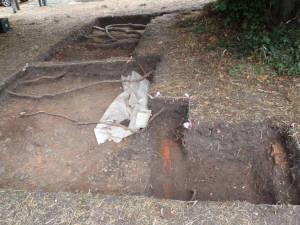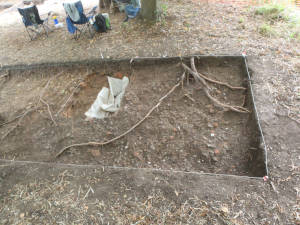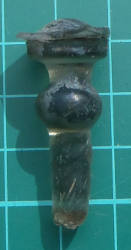27 Aug 2021
Forty Hall Summer Dig - Day 5

A day of mixed results today in Forty Hall, on day five of our two-week hunt for the inner gatehouse and brick water conduit of Elsyng Palace.
Following our failure to locate any trace of the brick water conduit we've been looking for in trench one, yesterday afternoon we had laid out an L-shaped extension on the western side of the trench, to reconnect with a trench from 2018 where we last saw the structure.
Early yesterday evening, reviewing site photography we were confident we had laid out the trench extension almost exactly in the right spot to pick up the line of the conduit, and it was the work of a few minutes this morning to confirm this by revealing the top of the two sides of the channel as previously excavated. The question remained then, why there was no sign of it in the rest of trench one, particularly in the 50cm strip we extended to the south at the other end of the trench.

The simplest way to answer this may have been to follow the feature east, but frustratingly this will probably not be possible because of an active bees' nest about a metre from the corner of the trench. We did manage to extend a 50cm square section which shows the conduit continues straight for at least three more bricks, and after excavating the rest of the extended trench (left of picture), we're confident at least that the channel does not turn north.
We think it is very unlikely that the channel would come to an abrupt end, which leaves the possibility that it has been truncated by generations of tree planting in the lime avenue. If this is the case, we ought to find its continuation beyond the tree line within the open area of the avenue itself, and we may open a small trench over on the east side of trench one to test this theory over the weekend.

Meanwhile in trench two we extended a further two metres at its east end and widened the trench by a metre to investigate the coarse rubble deposits we've been excavating in this area.
So far we have removed topsoil and revealed the pebble/rubble context seen earlier in the week. At this end of the trench the surface has a steep northerly slope, which we have also picked up in other contexts at the other end of the trench. Tomorrow we'll aim to reveal and further investigate the rubble.

The nicest find of the day, which unfortunately came from topsoil and so is of no use for dating stratigraphy, was part of the stem of a 17th century wine glass - technically known as the 'knop'.
We've actually found quite a few of these on the site over the years, often of a similar date, probably when the palace was in the keepership of Phillip Herbert, first Earl of Montgomery. Maybe he or one of his servants had a shaky hand!